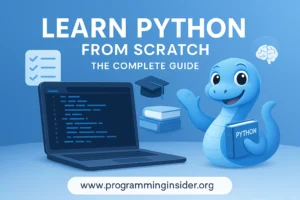According to a 2023 Stack Overflow Developer Survey, nearly one in three developers report struggling with recursion when first learning to code. Yet, recursion is a fundamental concept that appears across many programming languages and disciplines from solving puzzles and traversing data structures to performing complex algorithmic calculations.
So what is recursion in programming?
Recursion is when a function calls itself to solve a smaller part of a larger problem. It continues doing this until it reaches a condition known as the base case, which stops the recursive calls. Think of it as a strategy where a problem is broken down into simpler versions of itself, solved layer by layer.
Visualizing How Recursion Works
Let’s break it down using a simple factorial example.
The factorial of a number
n, written asn!, is the product of all positive integers less than or equal ton.
Here’s a visual flow for factorial(4):
factorial(4)
→ 4 * factorial(3)
→ 3 * factorial(2)
→ 2 * factorial(1)
→ 1 (base case)
= 4 * 3 * 2 * 1 = 24
Why Use Recursion?
Recursion often makes code more readable and elegant, especially when dealing with problems that have naturally recursive structures such as:
- Navigating trees (e.g., DOM or file systems)
- Backtracking (e.g., solving a maze or puzzle)
- Divide-and-conquer algorithms (e.g., Merge Sort, Quick Sort)
- Mathematical computations (e.g., Fibonacci numbers)

Common Recursive Patterns
1. Factorial Function (as above)
def factorial(n):
if n == 1:
return 1
return n * factorial(n - 1)
2. Fibonacci Sequence
def fibonacci(n):
if n <= 1:
return n
return fibonacci(n - 1) + fibonacci(n - 2)
Note: This is a classic example, but it’s not the most efficient way to calculate Fibonacci numbers due to repeated work.
3. Sum of a List
def sum_list(lst):
if not lst:
return 0
return lst[0] + sum_list(lst[1:])
Iteration vs Recursion
| Feature | Recursion | Iteration |
|---|---|---|
| Code Length | Short and expressive | Longer but sometimes more efficient |
| Memory Usage | Higher (due to call stack) | Lower |
| Readability | More intuitive for tree-like problems | Easier to follow for simple loops |
| Risk | Stack overflow if base case is missing | Lower risk if written correctly |

Common Pitfalls
Even experienced programmers sometimes fall into these traps:
- Missing a base case: This leads to infinite recursion.
- Incorrect return value: Not returning the correct recursive value can break the logic.
- Too deep recursion: Some languages have recursion depth limits (e.g., Python’s
RecursionError).
Recursion in Real-World Applications
Here are just a few places recursion appears in practice:
- Compilers and Interpreters: Parsing expressions often uses recursive algorithms.
- Game AI: Algorithms like minimax (used in chess or tic-tac-toe) use recursion.
- File System Navigation: Tools like
lsandfindoften recurse through directories.
Final Thoughts
Recursion is a powerful concept. Once you understand how to define a problem recursively with a base case and a reducing step. It can simplify how you solve complex problems. While it might seem tricky at first, especially to beginners, the more you see it applied in different contexts, the more natural it becomes.
For a deeper dive, try converting recursive solutions into iterative ones and vice versa. It’s a great way to strengthen your mental model.

FAQs
What is recursion in simple terms?
Recursion is when a function calls itself to solve a smaller part of a larger problem. This repeats until a base condition is met, which stops further calls. It’s like solving a puzzle by breaking it into smaller, easier pieces.
When should I use recursion instead of a loop?
Use recursion when:
- The problem has a naturally recursive structure (e.g., trees, nested folders)
- You want cleaner, more readable code
- The number of steps is not easily determined in advance
Use loops when:
- You need better performance and memory efficiency
- The task is repetitive and linear
What is a base case in recursion?
The base case is the condition that stops the recursive function from calling itself indefinitely. It acts like the “exit gate” of the recursion. Without it, you’d hit a stack overflow error.
Example:
if n == 1:
return 1 # This is the base case
What are common problems solved using recursion?
Some common problems include:
- Calculating factorials or Fibonacci numbers
- Searching or traversing tree structures
- Solving mazes or puzzles (backtracking)
- Dividing arrays in sorting algorithms (e.g., merge sort)
Is recursion less efficient than iteration?
Generally, yes—recursive functions use more memory because each function call gets added to the call stack. That said, for certain problems, recursion makes code much easier to understand and maintain.
Can all recursive functions be written iteratively?
Yes. Any recursive function can be rewritten using loops and sometimes a stack. However, the code might become longer or more complex.
What happens if I forget the base case?
If you forget the base case or write it incorrectly, the function will keep calling itself endlessly until the program crashes due to a stack overflow (in most languages).
What is tail recursion?
Tail recursion is a special case where the recursive call is the last thing a function does. Some programming languages can optimize this to improve performance, but not all languages support this optimization. Python, for example, does not.



